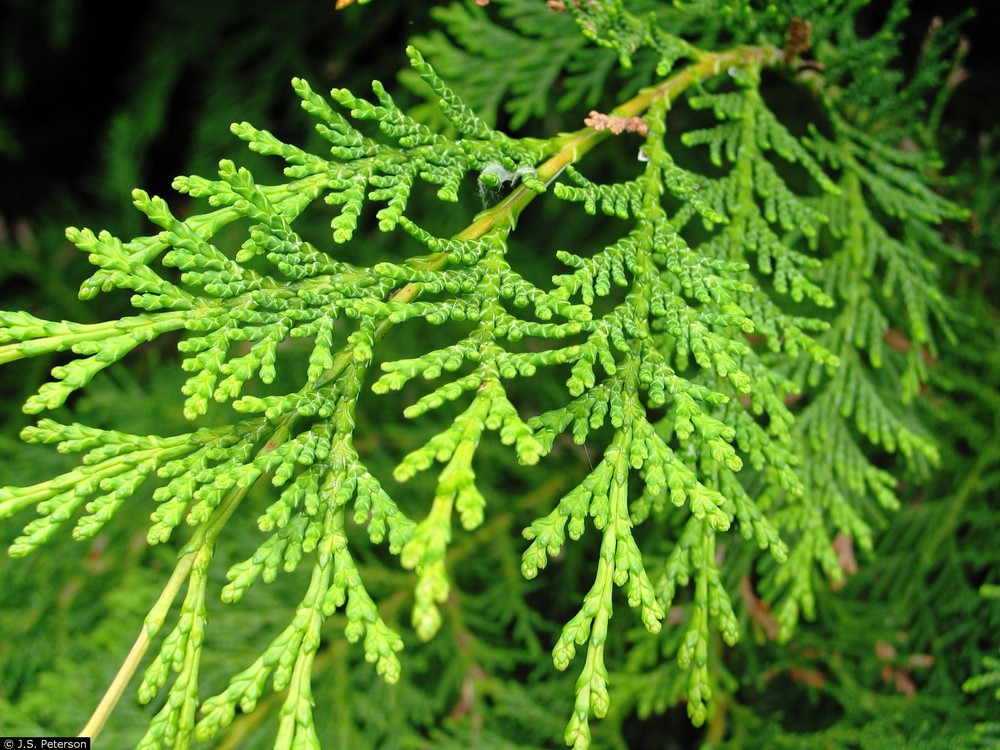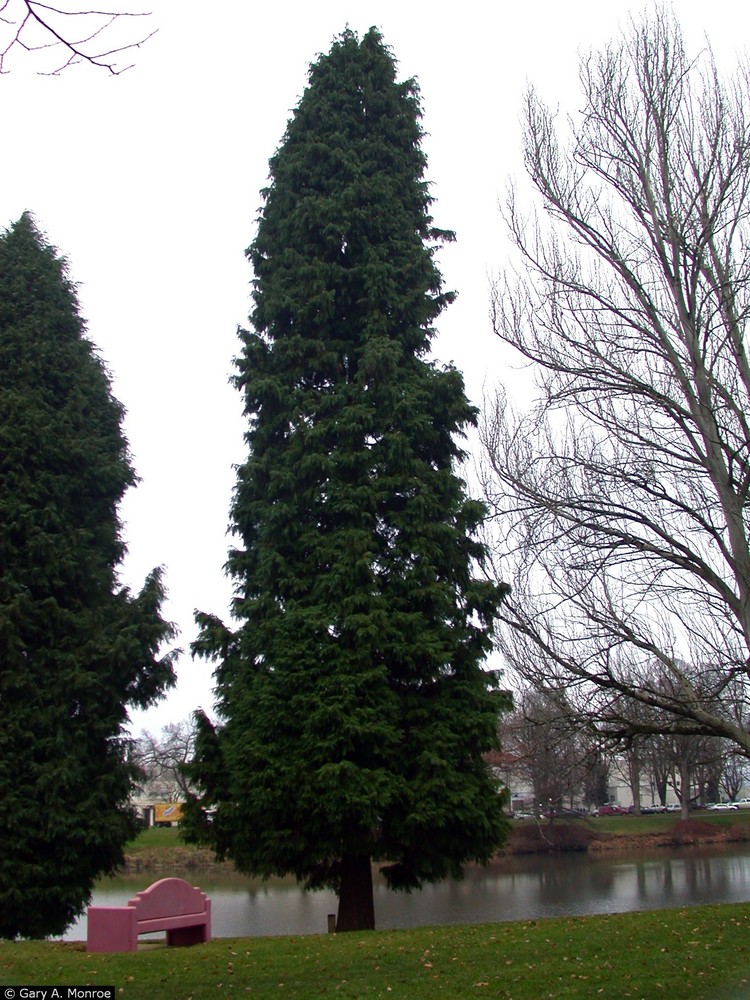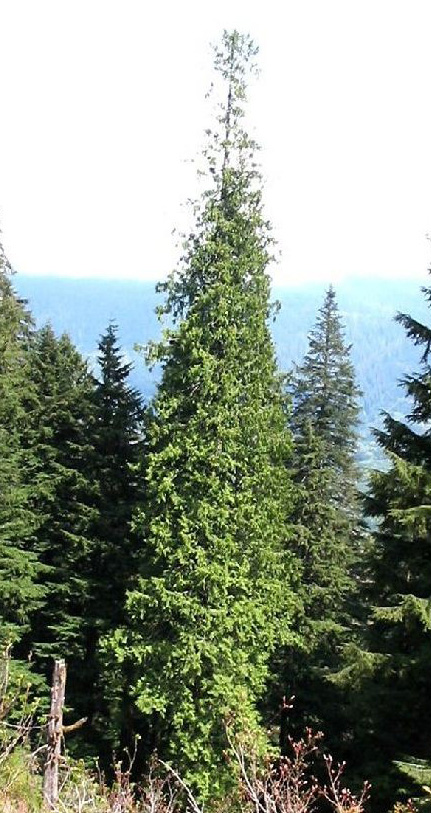Port-Orford-cedar (Chamaecyparis lawsoniana)—also known as white or Oregon-cedar, ginger-pine, or Lawson cypress—is widely known and recognized for its horticultural uses and the quality of its wood. Its species name, lawsoniana, honors Charles Lawson (1794-1873), the Edinburgh nurseryman who first introduced the species to horticulture.
There are five species of Chamaecyparis: Port-Orford-Cedar in western North America, the other four species in eastern Asia.
Port-Orford-cedar's native range is limited to southwest Oregon and northwest California, from Coos Bay to Humboldt County, California, and in isolated populations east to Oregon Caves National Monument and the Sacramento River canyon near Mount Shasta. The Coast Mountains of Oregon's Coos and Curry counties have the largest stands of Port-Orford-Cedar.
Inland, Port-Orford-cedar grows in the margins of fens and riparian zones with serpentine soils. Coastal populations grow in deep soils with a variety of other conifers. It is not unusual to find charcoal on the bark of large old trees indicating that they survived many fires. Some trees may exceed 350 years old. The largest known tree is found at Elk Creek southeast of Powers, Oregon, in the Rogue/Siskiyou National Forest. It is 229 feet tall and 12 feet in diameter.
Native Karok people of northwest California used Port-Orford-cedar branches as brooms and timber to construct sweat lodges, stools, and headrests. The rest of the world knows Port-Orford-cedar as a handsome cultivated plant with a great diversity of sizes, shapes, and colors; more than 200 cultivars are used for bonsai, hedges, and more. It is also a highly desirable and valuable timber tree, especially in Japan, where it is used to construct coffins, temples, and fine homes. The wood is light, strong, fine grained, and aromatic, which makes it insect resistant.
Port-Orford-cedar has been used in the manufacture of Venetian blind slats, storage battery separators, sashes, doors, interior finish mill work, hope chests, matches, dock planking, and a host of other wooden things, including posts, flutes and other musical instruments, arrow shafts (manufactured in Myrtle Creek, Oregon), boats, and woodcarving. Soap and insect repellent are made from the volatile oils of the wood.
In 1923, a killer root disease of unknown origin, Phytophthora lateralis, appeared on nursery plants near Seattle. The disease slowly advanced south in running water and soil contaminated with fungal spores on construction and logging machinery, vehicles, shoes, and livestock until it reached the cedar's native range in the mid-1950s. Mortality of trees has been high in areas infected ten years or more. Sanitation, quarantine, and resistant trees are the only defense.
Disease and logging are putting the survival of Port Orford cedar at risk. Stewardship of this ecological and economic treasure will be required to ensure its survival as part of the Oregon story.
-
![Port Orford cedar.]()
Port Orford Cedar, branch detail.
Port Orford cedar. Photo by J.S. Peterson, USDA-NRCS PLANTS Database
-
![Port Orford cedar (Chamaecyparis lawsoniana (A. Murray) Parl.).]()
Port Orford Cedar, entire tree.
Port Orford cedar (Chamaecyparis lawsoniana (A. Murray) Parl.). Photo by Gary A. Monroe, USDA-NRCS PLANTS Database
-
![Port Orford cedar.]()
Port Orford Cedar, bark and branch detail.
Port Orford cedar. Photo by Susan McDougall, USDA-NRCS PLANTS Database
Related Entries
-
![Incense-cedar]()
Incense-cedar
Incense-cedar (Calocedrus decurrens) tolerates a variety of ecological …
-
![Western red cedar]()
Western red cedar
Western red cedar (Thuja plicata) is one of the grand trees that grows …
Related Historical Records
Map This on the Oregon History WayFinder
The Oregon History Wayfinder is an interactive map that identifies significant places, people, and events in Oregon history.
Further Reading
Arno, S.F., and R.P. Hammerly. Northwest Trees: identifying and Understanding our Native Trees, rev. ed. Seattle: Mountaineers, 2007.
Jensen, E.C., and C.R. Ross, Trees to Know in Oregon, rev. ed. Corvallis: Oregon State University Extension Service, 2005.
Moerman, D.E. Native American Ethnobotany. Portland, Ore.: Timber Press, 1998.
Van Pelt, R. Forest Giants of the Pacific Coast. Seattle: University of Washington Press, 2001.





